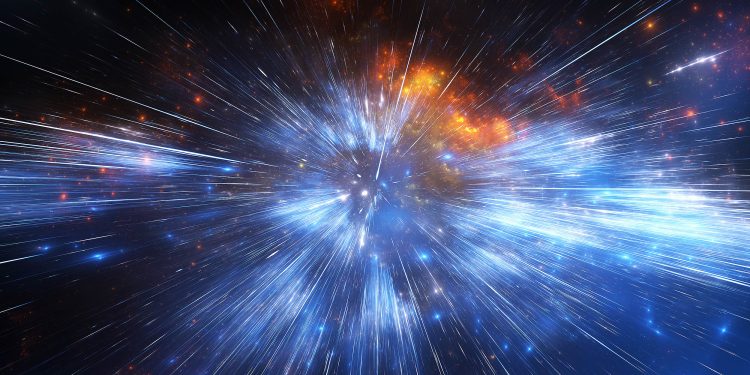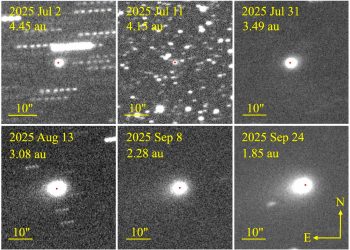Astronomers know that the universe is expanding and that its rate of expansion is continually accelerating. Most explanations rely on “dark energy” to explain this phenomenon, but a new study takes a different route.
An international team of researchers from the Center for Applied Space Technology and Microgravity (ZARM) at the University of Bremen and the Transylvanian University of Brașov in Romania has concluded that the expansion of the universe can be explained – at least in part – without involving dark energy.
This intriguing theory modifies the geometry of spacetime itself and shows that acceleration can occur even when spacetime contains no additional energy components.
The approach keeps the ingredients simple and rewrites the rules for measuring distance and time.
By deriving the large-scale equations within this new configuration, the authors show how the accelerated expansion of the universe can occur without inserting a cosmological constant into the equations where, in their view, it does not belong.
Understanding the Standard Model
Einstein’s general relativity links matter and geometry: mass and energy curve space-time, and this curvature guides movement.
Assuming that the universe looks the same on a large scale, we arrive at the Friedmann equations, which track how the scale of the universe changes over time.
To match the observed acceleration with these equations, cosmologists typically add a constant energy density, often called dark energy. It fits the data well, but extends the model by adding a separate ingredient.
How Finsler geometry differs
The study replaces the usual Riemannian geometry with Finsler geometry. In the standard case, the measured intervals do not depend on the direction or state of movement.
In a Finsler spacetime, the metric can depend on both. This direction- and speed-dependent structure lies inside the definition of spacetime rather than outside it.
Working within this framework, the authors derive gravitational field equations, then obtain a cosmological analogue of Friedmann’s equations, the Finsler-Friedmann equation.
It plays the same role as in standard cosmology, but reflects the new metric’s dependence on motion and direction.
Matter, geometry and the expansion of the universe
The treatment of the material also changes. In general relativity, gases and other many-particle systems are summarized by an energy-momentum tensor constructed from the second moment of a one-particle distribution function.
This summary excludes higher moments that describe asymmetries and detailed structure.
Here, geometry and matter live in the same phase space (positions and speeds). Since the metric depends on direction and speed, higher moments naturally contribute to gravity.
The kinetic description remains intact instead of being reduced to a single summary of the second moment. Matter and geometry impact the expansion of the universe by being associated at the same level of detail.
Acceleration without dark energy
Solving the Finsler-Friedmann equation for a homogeneous, isotropic universe (it appears identical when looking in any direction) yields a vacuum solution with exponential growth in the scale factor.
In the standard picture, this behavior requires a cosmological constant. In this construction, the acceleration comes from the geometry itself.
This is the central result: by allowing direction- and velocity-dependent measurements, the expansion accelerates even when the average energy density has no dedicated dark energy term.
Causality and local physics
Changing the geometry raises questions about cause and effect. The causal structure appears in the form of cones of light that determine which events can influence others.
The analysis only shows slight deformations of the light cones compared to the standard case. For observers and particles moving slowly relative to the cosmic rest frame, the differences remain small.
This behavior allows tested predictions of general relativity to be preserved at ordinary speeds and scales. This framework provides a way to adjust the large-scale expansion while keeping well-known local physics intact.
Measuring the expansion of the universe
The path forward is based on hard data. Supernova measurements compare brightness and distance to map the history of the expansion.
Galaxy studies measure a preferred scale defined by acoustic oscillations of baryons (a regular pattern of galaxy spacing).
The cosmic microwave background records the geometry and content of the early universe. The growth of the structure follows how low-density ripples grew into galaxies and clusters.
The standard model performs well in these tests. A model based on Finsler, as proposed in this study, must meet the same criteria.
This requires concrete predictions about the distance-redshift relationships, the BAO scale, the microwave background pattern, and the time dependence of structure growth.
Gravitational lensing provides another powerful control because it traces how light follows the geometry of space-time near mass.
Many questions left unanswered
Any alternative theory must remain consistent with precision tests carried out in the solar system and with measurements of binary pulsars.
This should also fit with what we know about the early universe, including a very rapid expansion phase and its subsequent transition to standard behavior.
The stability and behavior of small disturbances are also important; the evolution of the ripples influences structure, lensing, and tiny directional differences.
These questions set clear goals for theory and observation. They determine whether the geometry-based mechanism fits the sky as well, or better, than the current model.
Universe, expansion rate and next steps
This work shows two levers in cosmology: the inventory of what fills the universe and the rules that measure it.
The usual path explains the acceleration by adding a constant energy density. This study allows the inventory to be reduced and the metric to be modified so that direction and movement influence the measured intervals.
In this framework, the accelerated expansion of the Universe appears without the need for mysterious and elusive dark energy.
“This is an exciting indication that we might be able to explain the accelerated expansion of the universe without dark energy, based on a generalized space-time geometry,” concludes ZARM physicist and research team member Christian Pfeifer.
“The new geometry opens up completely new possibilities for better understanding the laws of nature in the cosmos.”
If the predictions match supernovae, galaxy clustering, microwave background, lensing, and structure growth, then geometry alone could explain the observed acceleration.
Otherwise, the comparison will refine our understanding of how measurement rules shape cosmic dynamics. Either way, the idea is testable.
The full study was published in the Journal of Cosmology and Astroparticle Physics.
—–
Do you like what you read? Subscribe to our newsletter for engaging articles, exclusive content and the latest updates.
Check us out on EarthSnap, a free app brought to you by Eric Ralls and Earth.com.
—–









